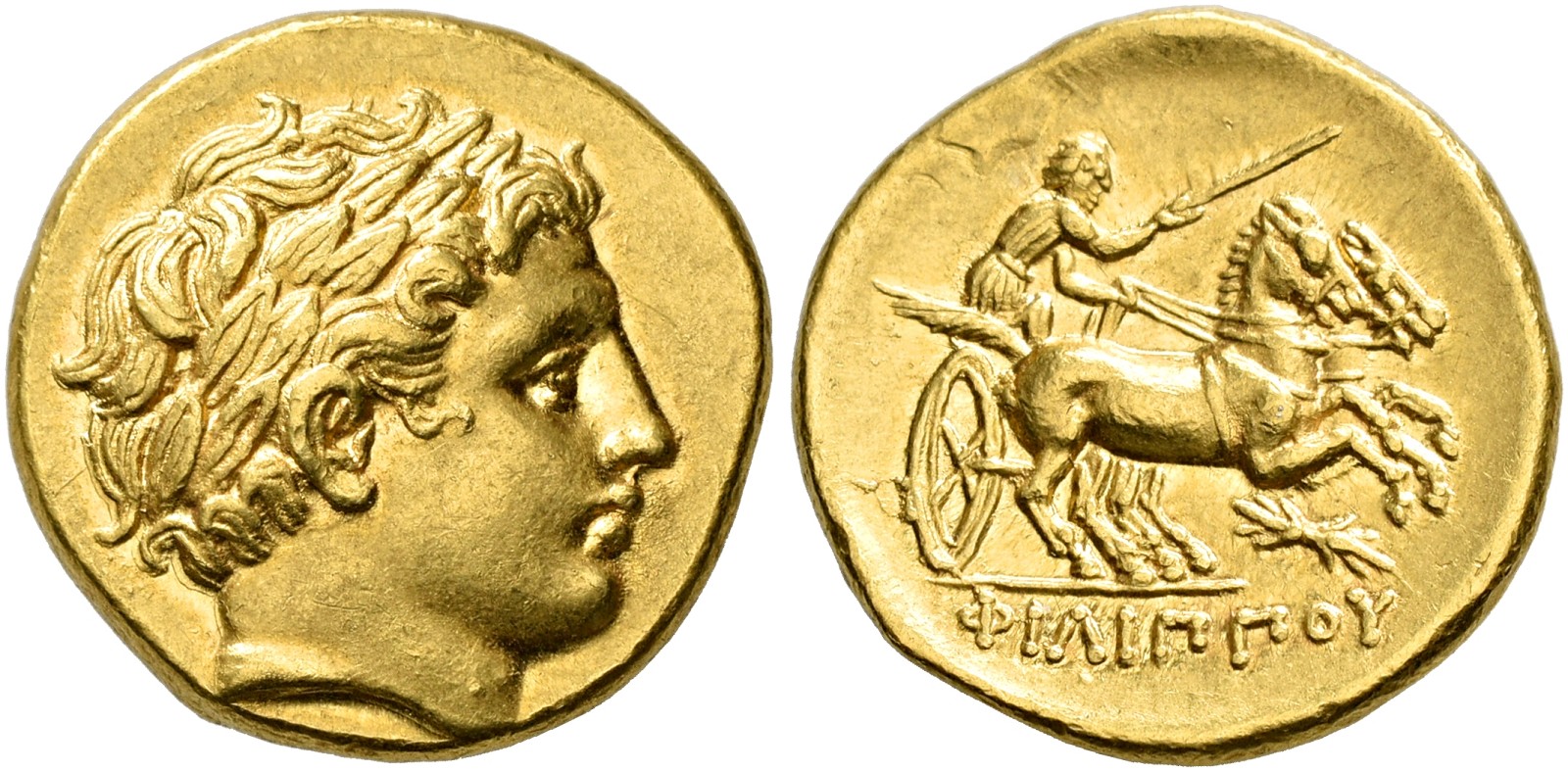Pella (Philip II), gold, staters (Group III) (323-310 BCE)
From SILVER
323 BCE - 310 BCE Gold 176,865 kg
Description
| ObverseInscription or printing placed on the obverse.: | Head of Apollo right, wearing laurel wreath. |
| ReverseInscription or printing placed on the reverse.: | ΦΙΛΙΠΠΟΥ (Greek).Charioteer driving chariot drawn by two rearing horses to right, holding reins in his left hand and goad in his right |
Mint and issuing power
| MintIdentifies the place of manufacture or issue of a numismatic object.: | Pella | Ancient regionAncient region.: | Macedon | Modern countryModern country: Greece | AuthorityIdentifies the issuing power. The authority can be "pretended" when the name or the portrait of X is on the coin but he/she was not the issuing power. It can also be "uncertain" when there is no mention of X on the coin but he/she was the issuing power according to the historical sources: | Philip II (Argead king, 359-336 BC), Philipp III Arrhidaeus (Argead king, 323-317 BC) |
Chronology
| FromIdentifies the initial date in a range assigned in a numismatic context. | 323 BCE | toIdentifies the final date in a range assigned in a numismatic context.. | 310 BCE | PeriodTime period of the numismatic object.: Classical and Hellenistic |
Physical description
| MetalThe physical material (usually metal) from which an object is made.: | Gold |
Median weightMedian of the weights of numismatic objects (in grams). in grams | 8.55 | DenominationTerm indicating the value of a numismatic object. Examples: tetradrachm, chalkous, denarius.: | stater |
StandardStandard.: | Attic |
Image

H 96 - Pella, Group III (Alexander IV), gold, staters (323-310 BCE) BC.jpg [1]
References
| Die study referencePublication of the study: | Le Rider 19771Le Rider 1977, Pella, group III (c. 323/2-c. 310) | ||
| Coin series referenceReference to coin series study: | RQEMH2RQEMH, n° 96 | ||
| Coin series web referenceCoin series web references: | |||
Obverse dies distribution
| FrequencyFrequency of specimen in distribution. ᵖ | Number of obversesNumber of obverse dies. ᵖ (o) | % (o) | Number of coinsNumber of coins. (n) | % (n) | Die nameName(s) of the die(s). |
| 1 | 21 | 22.83 | 21 | 4.86 | 178, 179, 181, 205, 206, 207, 212, 214, 220, 223, 224, 225, 226, 227, 228, 232, 247, 254, 255, 258, 263 |
| 2 | 13 | 14.13 | 26 | 6.02 | 183, 190, 203, 204, 211, 216, 218, 219, 221, 241, 248, 261, 262 |
| 3 | 18 | 19.57 | 54 | 12.5 | 177, 180, 181, 194, 201, 208, 210, 215, 229, 240, 242, 243, 244, 249, 250, 252, 256, 259 |
| 4 | 6 | 6.52 | 24 | 5.56 | 198, 217, 231, 238, 239, 245 |
| 5 | 9 | 9.78 | 45 | 10.42 | 182, 193, 195, 200, 202, 209, 213, 222, 246 |
| 6 | 1 | 1.09 | 6 | 1.39 | 264 |
| 7 | 3 | 3.26 | 21 | 4.86 | 199, 230, 235 |
| 8 | 8 | 8.7 | 64 | 14.81 | 176, 186, 189, 191, 192, 257, 260 |
| 9 | 1 | 1.09 | 9 | 2.08 | 188 |
| 10 | 4 | 4.35 | 40 | 9.26 | 185, 186, 236, 251 |
| 11 | 1 | 1.09 | 11 | 2.55 | 237 |
| 12 | 1 | 1.09 | 12 | 2.78 | 253 |
| 14 | 1 | 1.09 | 14 | 3.24 | 233 |
| 16 | 2 | 2.17 | 32 | 7.41 | 184, 196 |
| 17 | 2 | 2.17 | 34 | 7.87 | 197, 234 |
| 19 | 1 | 1.09 | 19 | 4.4 | 187 |
| Total | 92 of 92 | 100.02 | 432 of 432 | 100.01 |
Reverse dies distribution
no distribution is available
Quantification
| Number of obversesNumber of obverse dies. ᵖ (o) | 92 | Number of singletons (o1)The number of singleton coins. ᵖ | 21 |
| Number of reverse diesNumber of reverse dies. (r) | 170 | Number of coinsNumber of coins. (n) | 432 |
| Coins per obverse dieNumber of coins per obverse die. (n/o) | 4.7 | Coins per reverse dieNumber of coins per reverse die. (n/r) | 2.54 |
| Reverse per obverse ratioRatio of obverse dies divided by reverse dies. (r/o) | 1.85 | Percentage of singletons (o1)number of coins (n) divided by the number of singletons (o1) ᵖ | 22.83 % |
| Original number of dies (O) (Carter 1983 formula)The estimation of the number of coins according to Carter 1983 ᵖ | 103.43 | Coins struck if 20,000 as average productivity per dieCoins made if the average productivity for obverses (according to Carter) is 20,000. ᵖ | 2,068,600 |
| Original number of dies (O) (Esty 2011 formula)The estimation of the number of coins according to the singleton formula in Esty 2011 ᵖ (O) | 116.89 | Survival rate if 20,000 as average productivity per dieSurvival rate if average productivity is 20,000. ᵖ | 0.00021 |
| Coverage (o = % of O) (Esty 1984 formula)Esty 1984 - coverage (% of O) ᵖ (o = % of O) | 95.14% | Die productivity if survival rate 1/2,000Average productivity if survival rate is 1/2,000. ᵖ | 8,353.48 |
| Weight of silver (in kg) if 20,000 coins per die (O = Carter formula)Carter 1983 * Median weight * 20000 (*10 if gold or electrum) ᵖ | 176,865 kg <br /> 176,865 kg | Die productivity if survival rate 1/5,000Average productivity if survival rate is 1/5,000. ᵖ | 20,883.69 |
Remarks
Most likely one single workstation Certainly military